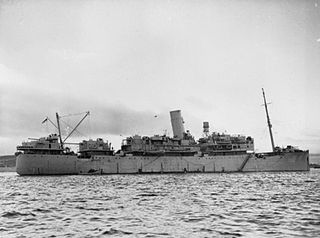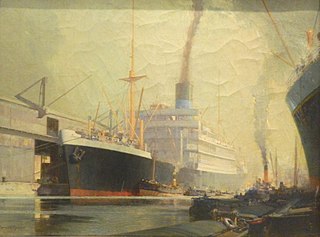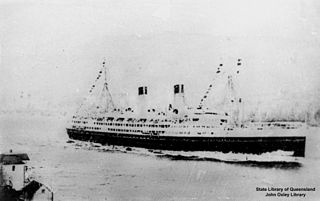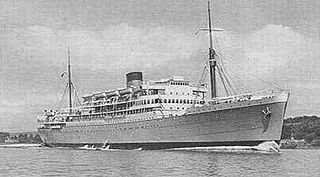
HMS Cheshire was a passenger ship that was built in Scotland in 1927 and scrapped in Wales in 1957. She belonged to Bibby Line, which ran passenger and cargo services between Rangoon in Burma and various ports in Great Britain, via the Suez Canal and Gibraltar. The Admiralty requisitioned her in 1939 and had her converted into an armed merchant cruiser (AMC). She was converted into a troopship in 1943, and returned to civilian service in 1948.

SS Ceramic was an ocean liner built in Belfast for White Star Line in 1912–13 and operated on the Liverpool – Australia route. Ceramic was the largest ship serving the route until P&O introduced RMS Mooltan in 1923.

RMS Caronia was a Cunard Line transatlantic steam ocean liner. She was launched in 1904 and scrapped in 1932. In World War I she was first an armed merchant cruiser (AMC) and then a troop ship.

RMS Carmania was a Cunard Line transatlantic steam turbine ocean liner. She was launched in 1905 and scrapped in 1932. In World War I she was first an armed merchant cruiser (AMC) and then a troop ship.
SS Antenor was a UK steam turbine passenger and refrigerated cargo liner launched in 1924. She was the third of five ships to bear the name.
SS Patroclus was a UK steam turbine passenger and refrigerated cargo liner launched in 1923. She was the third of five ships to bear the name.

SS Sarpedon was a UK steam turbine passenger and refrigerated cargo liner launched in 1923. She was the fourth of six ships to bear the name.

HMS Hector was a UK steam turbine passenger and refrigerated cargo liner launched in 1924. She was the fourth of six civilian ships to bear the name.
SS Automedon was a Blue Funnel Line refrigerated cargo steamship. She was launched in 1921 on the River Tyne as one of a class of 11 ships to replace many of Blue Funnel's losses in the First World War.
Savoia was a 5,490 ton refrigerated cargo ship which was built in 1922. She was captured by the Royal Navy in 1941 and renamed Empire Arun. In 1947 she was sold and renamed Granlake. Further name changes were Dryad in 1949, Shiranesan Maru in 1951 and Dainichi Maru in 1962. She was scrapped in 1968.

SS Letitia was an ocean liner built in Scotland for service with the Anchor-Donaldson Line. She continued to serve with its successor company Donaldson Atlantic Line. At the start of the Second World War in September 1939, the British Admiralty requisitioned the ship for service and had it converted to serve as an armed merchant cruiser. She was withdrawn from this service in 1941 to become a troop ship.

Inkosi was a 6,618 GRT refrigerated cargo liner which was built by Swan, Hunter & Wigham Richardson Ltd, Newcastle upon Tyne for the Ministry of War Transport (MoWT). She was hired by the Royal Navy in 1940 for use as an ocean boarding vessel, but was sunk in an air raid before she could be used for this purpose. The ship was salvaged, converted to a cargo ship and passed to the Ministry of War Transport (MoWT), who renamed her Empire Chivalry. In 1946 she was sold and renamed Planter. She served until 1958, when she was scrapped.

Wahehe was a 4,690 GRT cargo ship which was built in 1922 as Wadigo by Reiherstieg Schiffswerfte und Maschinenfabrik, Hamburg for Woermann Linie AG. She was converted to a refrigerated cargo liner in about 1934.

Cameronia was a British ocean liner which was built in 1920 by William Beardmore & Co Ltd, Dalmuir for the Anchor Line. She was requisitioned for use as a troopship in the Second World War, surviving a torpedo attack. In 1953 she was requisitioned by the Ministry of Troop Transport (MoTT) and renamed Empire Clyde. She was scrapped in 1957.

MV Aorangi was a transpacific ocean liner and refrigerated cargo ship. She was launched in 1924 in Scotland and scrapped in 1953. Her regular route was between Sydney and Vancouver via Auckland, Suva and Honolulu.

SS Cap Polonio was a German 20,576 GRT ocean liner that was launched in 1914 and scrapped in 1935. She worked the Hamburg Südamerikanische Dampfschifffahrtsgesellschaft route between Hamburg in Germany and Buenos Aires in Argentina. She was named after Cabo Polonio in Uruguay.

RMS Tahiti was a UK Royal Mail Ship, ocean liner and refrigerated cargo ship. She was launched in 1904 in Scotland as RMS Port Kingston for a subsidiary of Elder Dempster Lines. In 1911 the Union Steamship Company of New Zealand bought her and renamed her Tahiti.

SS Cathay was a P&O passenger steamship that was built in Scotland in 1925 and sunk in the Mediterranean Sea in 1942. In the Second World War she was first an armed merchant cruiser and then a troop ship. In 1942 she took part in Operation Torch, and was sunk in a German air raid off Bougie, Algeria.
SS Ruahine was a UK-built ocean liner and refrigerated cargo ship. She was launched in 1909 in Scotland for the New Zealand Shipping Company, who operated her in scheduled service between Britain and New Zealand. She survived both World wars.

HMS Dunvegan Castle was a UK ocean liner that was converted into an armed merchant cruiser (AMC) in the Second World War. Harland and Wolff built her and her sister ship Dunnottar Castle in Belfast in 1936.
















